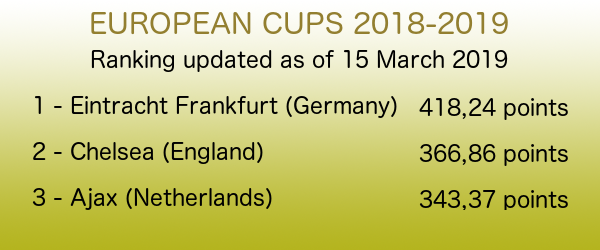How are the teams in the second divisions going?
At this link you find the 20 best teams that play in the second tier of the top 10 European leagues, according to the calculation method here explained.
For each team, the following are calculated:
- points made per game (PpG)
- average number of goals scored per game (AGF)
- average number of goals conceded per game (AGA)
Then the score is calculated with this formula:
(PpG + (AGF + AGA) / 2,5) * LC
where LC is the League Coefficient, set as follow.
I wanted to weight each league for its relative strenght, but I didn't have objective elements, since the second tier teams (usually) don't play international matches.
So, I decided to use the UEFA coefficients (relative to the first tier teams), adjusted in this way:
1) the average of the coefficients of the leagues involved (the first 10) is subtracted from each league's coefficient;
2) the result is divided by 1,5;
3) the new result is subtracted from the league's coefficient and multiplied by 2.
Example:
England's UEFA coefficient is 71,82 (as of today, 10 October 2014), and the average of the top 10 coefficients is 53,825.
(71,82 - 53,825) / 1,5 = 12
(71,82 - 12) * 2 = 119,64
So, the coefficient for the English second tier league ("The Championship") is 119,64.
The leagues considered are the following:
| Nation | League | Coefficient |
|---|---|---|
| Belgium | Proximus League | 92,96 |
| England | The Championship | 119,64 |
| France | Ligue 2 | 102,26 |
| Germany | 2. Bundesliga | 117,56 |
| Italy | Serie B | 109,88 |
| Netherlands | Eerste Divisie | 96,98 |
| Portugal | Segunda Liga | 109,14 |
| Russia | Division 1 | 102,2 |
| Spain | Segunda Division | 128,52 |
| Ukraine | Division 2 | 97,32 |
Come stanno andando le squadre dei campionati di secondo livello in Europa (come ad esempio la Serie B italiana)?
A questo link trovate le 20 migliori squadre che giocano nei principali 10 campionati europei, in base al metodo di calcolo spiegato qui di seguito.
Per ogni squadra, vengono calcolati:
- media dei punti fatti per partita (PpG)
- media dei gol segnati per partita (AGF)
- media dei gol subiti per partita (AGA)
Quindi la formula utilizzata è la seguente:
(PpG + (AGF + AGA) / 2,5) * LC
dove LC è il coefficiente del singolo campionato, stabilito come segue.
Avrei voluto pesare ogni campionato secondo la sua forza relativa, ma non avevo elementi oggettivi, dato che le squadre dei campionati di secondo livello non giocano (di solito) partite internazionali.
Quindi ho deciso di usare i coefficienti UEFA (relativi alle squadre di primo livello), modificati come segue:
1) la media dei coefficienti dei campionati considerati (i primi 10) è sottratto da ciascun coefficiente nazionale;
2) il risultato è diviso per 1,5;
3) il nuovo risultato è quindi sottratto dal coefficiente nazionale, e infine moltiplicato per 2.
Esempio:
Il coefficiente UEFA dell'Italia è 57,176 (ad oggi, 10 October 2014), e la media dei migliori 10 coefficienti è 53,825.
(57,176 - 53,825) / 1,5 = 2,234
(57,176 - 2,234) * 2 = 109,88
Quindi, il coefficiente della Serie B è 109,88.
I campionati presi in considerazione sono quelli presenti nella tabella mostrata sopra.






Nessun commento:
Posta un commento